
Chancel Cushions

Chancel Cushions
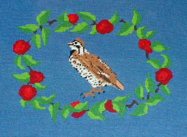
In memory of: Anina Mentz
|
The quail, mentioned in
Exodus 16:3, was a migratory bird. When Moses led the children of
Israel our to Egypt into the wilderness it is said that they were nearly
starving and Moses provided meat "and there went forth a wind from the
land and brought quail form the sea and let them fall by the camp."
The quail on this cushion is enclosed in a wreath of applewood and fruit (Proverbs 25:11) "a word fitly spoken is like apples of gold." Thus spoke Solomon, son of David. The apple also symbolizes the expulsion of Adam and Eve from Eden and when thus used, it represents greed and temptation. Apples are one of the chief agricultural products of the San Lorenzo Valley and the quail is the state bird of California. |
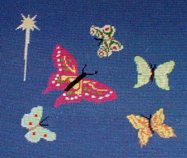
In memory of: Ora Walker
|
The butterfly is symbolic
of resurrection because of the three stages of its life. The larva
suggests the lowly condition of man on earth, the chrysalis the body of
man in the grave, and the butterfly the glorified body destined for eternal
life.
In the corner is a five pointed star - the symbol of the nativity. It is also used at Epiphany to denote the manifestation of Christ to the Gentiles. |
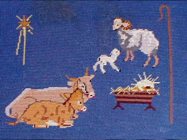
In memory of: Anna N. Berryman
|
Here are shown symbols of the Nativity: a sheep, an oxen and donkey standing by the manger; a star above; a shepherd's crook to the right; and the Christ Child in a cradle. |
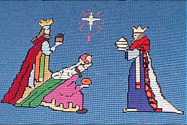
In memory of: Anna N. Berryman
|
The wise men and the star of Bethleham represent the Nativity. |
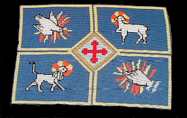
In memory of: Louise Raboli Worked by: Dellilah Powers |
The center of this cushion is divided into five tile like shapes with a different symbol for Christ in each area. The dove stands for His Holy Spirit. The lamb refers to Jesus as the Lamb of God. The hand embodies the idea that the hand of God is over the souls of the righteous. The lion is a symbol for Christ because it is associated with strength, majesty, and courage. The center tile holds the cross-crosslet composed of four Latin crosses arranged so that the base overlaps - suggestive of the four corners of the earth and the spreading of the Gospel through the world. |
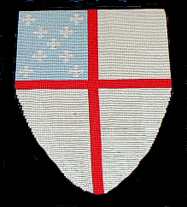
In memory of: Louise Raboli Worked by: Muffie Riddell |
On this cushion is worked the emblem of the Epicopal Church in the United States. It is made us of the shield of St. George which indicates our descent from the Church of England. The upper left hand quarter is taken from the shield of St. andrew, the nine cross-crosslets, symbolizing the nine original dioceses in America, are arranged to give the impression of a Saltire or x-shaped cross. The St. Andrew cross recalls our indebtness to the Scottish Church in connection with the consecration of the first bishop in America, Bishop Seabury, in Aberdeen, Scotland in 1784. |

In memory of: Anna N. Berryman
|
On the left is a ram lying
in a field of clover. Because the ram is the leader of the herd he
is used to symbolize Christ. He was also an animal of Jewish sacrifice
and is therefore associated with the crucifixion. Clover is a symbol
for the trinity because of the three leaves attached to each stem.
It is said that St. Patrick used the clover to explain the trinity in his
early preaching and it has since been associated with this saint.
On the right is an owl, symbol for satan because it shuns the light. It is sometimes used to express solitude and wisdom. It is also used to symbolize Christ "who gave light to them that sat in darkness and in the shadow of death." (Luke 1:70). This explains the presence of an owl in paintings of the crucifixion. The owl is sitting on a pine bough. This tree signifies boldness and fidelity. Between the owl and the ram is a spray of dogwood. The dogwood is a strong symbol of the crucifixion. The cross is supposed to have been made of wood from the dogwood tree which legend says grew very large in those days, but after the curcifixion God ordained that its size would be stunted from then on. The blossoms have a rust color mark in the center of each of the four petals which is said tor represent the stigmata. |

In memory of: Anna N. Berryman
|
The dragon is symbolic of sin and pestilence. When the dragon is shown under foot, he represents St. George and signifies victory over evil. The dragon is also the symbol of St. Philip. St. Philip is associated chiefly with the account of the feeding of the 5,000 (John 6:5) and also because he was present at the gathering of the disciples of Christ in Jerusalem after the ascension (Acts 1:13). In later life, St. Philip is supposed to have carried the Gospel to Scythia. There, according to legend, in the city of Hierapolis, he found the people worshipping a great serpent. Aided by the cross, St. Philip caused the serpent to disappear but it left behind such a terrible odor that many people died including the son of the king. Again, aided by the cross, Philip brought the youth back to life. The priests of the dragon were so enraged by the overthrow of their god they seized St. Philip and put him to death. |
Click here to view more chruch needlepoint and its history!
This site was designed courtesy of Crystal Cloud Graphics using digital camera images of the historic St. Andrew's Church in Ben Lomond, California and modified using XARA. This site is navigable for the seeing impaired. Contact web mistress Kythera Ann with comments or questions.
l GENERAL INFORMATION l E-MAIL l ACOLYTES l ACTIVITIES l ALTAR GUILD l ARTICLES l CALENDAR l CHOIR l CHURCH HISTORY l EDUCATION l WEDDINGS l LAY MINISTERS l LINKS l OFFICE l PLEDGES l READING GROUP l VESTRY l